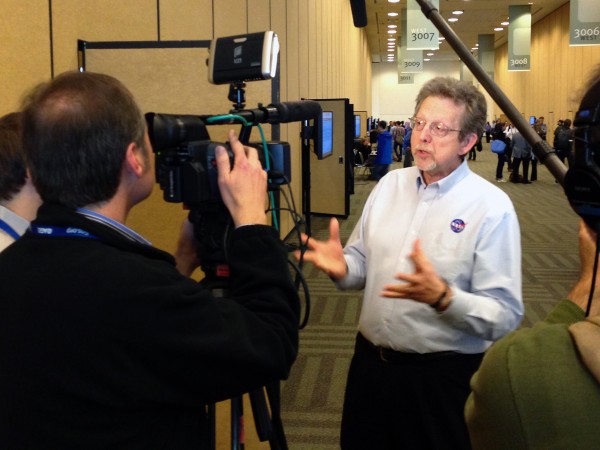17 February 2015
Science communication as a “responsibility”
Posted by mcadams

Jim Green, Director of NASA’s Planetary Science Division, gives a media interview after a 2014 Fall Meeting press conference. Several scientists discussed scientists’ responsibility to communicate with the public during the Communicating Science seminar at the 2015 Association for the Advancement of Science annual meeting in San Jose, California.
AGU’s Nanci Bompey reports from the Communicating Science seminar at the 2015 Association for the Advancement of Science annual meeting in San Jose, California. Watch video archives of the seminar on the AAAS 2015 Annual Meeting website.
By Nanci Bompey
SAN JOSE — As a practicing scientist, Noah Diffenbaugh spends most of his time working in his lab, interacting with his colleagues, and submitting his work to peer-reviewed scientific journals.
But, increasingly, Diffenbaugh, an associate professor of Environmental Earth System Science and senior fellow at the Woods Institute for the Environment at Stanford University, also spends a lot more time talking to the public about science. Diffenbaugh said because his research group is federally funded, he feels a responsibility to communicate about his work with the public. As a citizen, he also feels a responsibility about contributing to the public dialogue about climate change.
“I am a scientist, first and foremost, but I feel it is my responsibility to answer questions from the public when I am asked,” Diffenbaugh said during a panel on communications Feb. 12 at the American Association for the Advancement of Science annual meeting in San Jose, California.
Studies show that more scientists than most people assume are communicating about their work with the public, said Anthony Dudo, a professor at the University of Texas who examines the intersection of science, media and society, during a separate panel on communications Feb. 12 the AAAS meeting in San Jose. Science communication is becoming a hot topic, with more training and opportunities for scientists to communicate with the public than ever before, Dudo said.
“The calls for scientists to be better communicators are perhaps louder than they have been in quite a while,” he said.
Recent surveys show that most scientists who interact with the public often have a positive experience, Dudo said. Scientists say that they find it personally enjoyable and get “immense gratification” from communicating with the public, he said. Communicating about science can also help enhance scientists’ reputations and increase visibility for funding for their research, Dudo said.
But incentivizing and convincing busy scientists to communicate about their science with the public can be difficult when outreach and communication is not valued in a tangible way in the academic world, Dudo said.
However, some scientists – especially younger scientists – care about social justice and science literacy, and believe it is their duty as a member of society to communicate about their work with the public, said Heidi Ballard, an associate professor at the University of California Davis School of Education, during the panel with Dudo.
The National Science Foundation, as part of their grant process, has also increasingly asked scientists to show that their research has a broader societal impact, said Nalini Nadkarni, a professor at the University of Utah, during the same panel. Communicating with the broader public or underserved groups can fulfill that requirement. Showing the broader impact of research can also help applicants vying for competitive grants in areas like environmental science stand apart from their peers, she added.
Nadkarni said the value that an institution places on communication can also make a difference.
“What institutions think about (communication) reflects very strongly on what faculty and graduate students can do,” she said.
– Nanci Bompey, AGU public information specialist/writer










 The Plainspoken Scientist is the science communication blog of AGU’s Sharing Science program. With this blog, we wish to showcase creative and effective science communication via multiple mediums and modes.
The Plainspoken Scientist is the science communication blog of AGU’s Sharing Science program. With this blog, we wish to showcase creative and effective science communication via multiple mediums and modes.